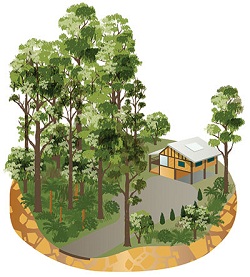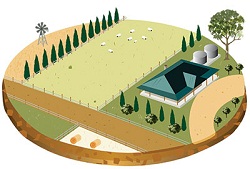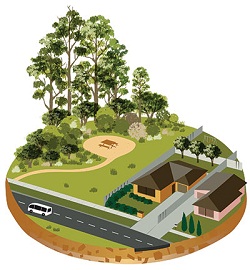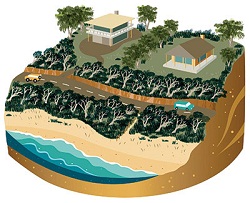Know your risk
Living with the bush is part of living in New South Wales – but so is living with the risk of fire.
A bush or grass fire can happen at any time of the year but the risk is higher during the warmer months, when bush, grass or scrub is drier.
You don't have to live right near the bush to be at risk. Even if your home is a few streets back, you may be at risk.
You can check for bush fire prone areas in your area on your local council website. Look for your Bush Fire Prone Land Map.
Check if you live on Bush Fire Prone Land.
Grasslands cover approximately 80% of New South Wales.
There is an increased risk of grass fires this summer. It is important that you understand grass fires and how to protect yourself, your family and your property from the threat of fire. Grass fires are unpredictable; they can start anywhere, spread rapidly and move three times as fast as a bush fire.
Think about the area you live in
 | I live in an area surrounded by bushWhat to expect:
|
 | I live close to grassland or paddocksWhat to expect:
|
 | I live in an area where the bush or grasslands meet built-up areasWhat to expect:
|
 | I live near the coastWhat to expect:
|
Think about the area you live in

I live in an area surrounded by bush
What to expect:
- Fires in dense bushland can be very hot, intense and fast moving
- Burning embers may be blown from the bush, landing on your property and starting spot fires or setting fire to your home
- Embers may land for many hours even after the main fire front has passed
- Smoke and fire may affect driveways or homes, making it difficult to leave
- The radiant heat from a fire nearby may set fire to your home or surrounds

I live close to grassland or paddocks
What to expect:
- Grass fires can start easily and spread quickly, not only destroying homes but also crops and livelihoods
- Grass fires are very hot and can produce huge amounts of heat which can kill anyone out in the open
- As grass dries out or cures, it can catch fire more easily
- Fires in tall grass will have tall flames that may burn across trails, roads or fire breaks
- Grass fires can move much faster than a bush fire, catching people off guard

I live in an area where the bush or grasslands meet built-up areas
What to expect:
- Fires can spread quickly from parks and reserves, threatening your home, fences or gardens
- Thick smoke from the fire might make it difficult to see or breathe
- Even if you live a few streets back from the bush, you are at risk from ember attack
- Burning embers can travel through the air, setting fire to homes a few streets back from the bush

I live near the coast
What to expect:
- Burning scrub or coastal heath can be very hot and burn very quickly
- Fires burning in coastal areas can reach homes quickly
- Access may be difficult, especially if roads in the area are busy or blocked
- Burning embers may be blown from the fire towards your home, starting spot fires
Fire behaviour
There are a number of things which can affect the way a fire burns, including:
- Slope – a fire travelling uphill will travel faster. In fact, for every 10 degrees of slope, a fire can double its speed. As a fire speeds up, it becomes more intense and more dangerous.
- Vegetation – smaller items such as twigs, branches and leaves are known as 'fine fuels'. These can burn very easily. Burning bark, twigs and leaves can also be blown in the wind.
- Weather – when it's hot, dry and windy, fires can be more intense and unpredictable. Strong winds can send a fire in different directions and cause burning embers to be blown through the air.
Know your risk and be prepared
Even if you're not at high risk, here are some tips to help make you, your family and your home safer.
Make a plan and talk about it
Make sure your family has a general understanding about bush fires and bush fire safety. If they are in an area that is affected by a bush fire, such as at work or on holiday, they will be able to make the safest choices. Our My Fire Plan website can help you make these decisions.
Make preparations to your home.
Embers can travel many kilometres ahead of a fire, so even if you are not directly threatened by a bush fire, you may be impacted by embers. Preparing your home can reduce the risk of embers starting spot fires around your home. For tips on what you can do to prepare your home, download our Prepare Your Home Fact sheet.
Keep yourself informed on days of increased fire danger.
Pay attention to your local radio and TV stations and monitor our website and social media pages on hot, dry, windy days. This will help you plan your day and make sure you avoid areas where there is an increased risk of a bush fire.
The NSW RFS acknowledges the assistance of the Country Fire Authority in preparing this material.



